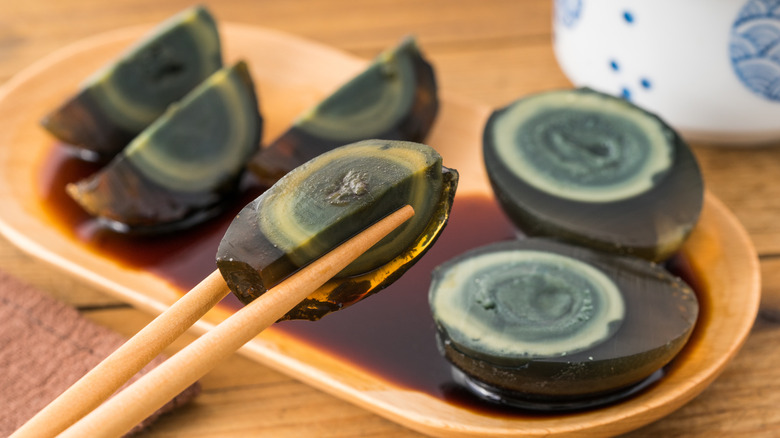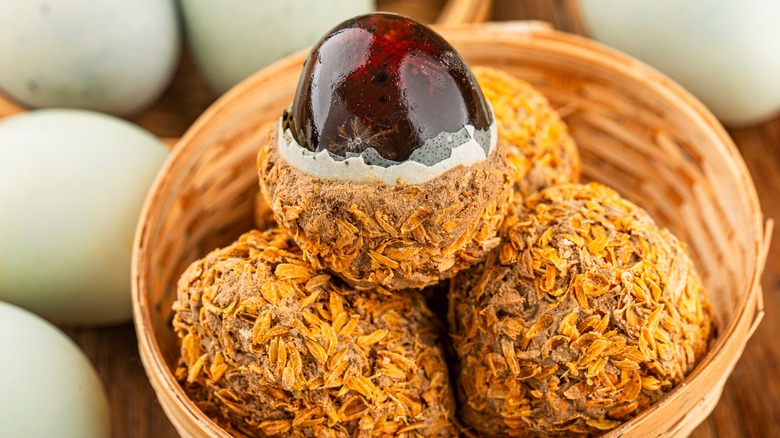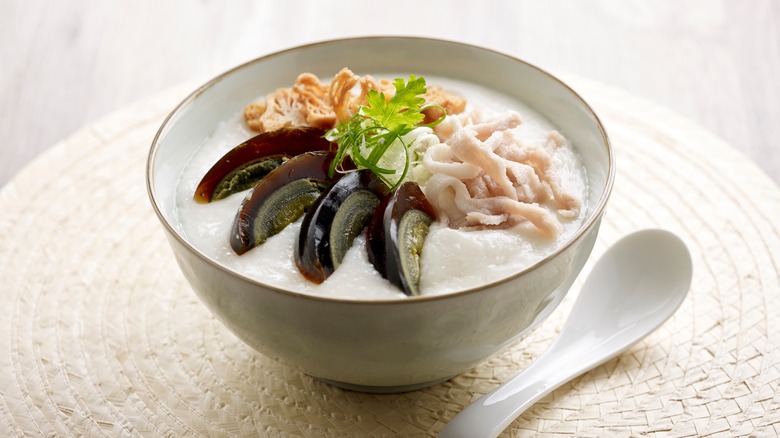Century Eggs Are The Chinese Delicacy With A Misleading Name
In Western countries like the U.S., there's no shortage of misconceptions around ingredients and cuisines from other parts of the world — case in point, the myth that MSG is dangerous to eat. While that one might have been widely debunked, some other falsehoods live on, like the widely misunderstood century egg, a delicacy you might encounter in China, but also further afield in east and southeast Asia, from Japan to Thailand.
In the case of century eggs, the name itself is a lie: These eggs are widely and incorrectly thought to be literally one hundred years old. They've even been called "millennium" or "thousand-year" eggs, unsurprisingly implying that they've somehow been preserved for 1,000 years. This is not even close to the truth: In reality, century eggs are preserved for at least a few weeks, and at most a few months. Century eggs are usually duck eggs, and the preservation process gives them a pungent flavor that's heavy on the umami notes; the taste is sometimes described as a little like blue cheese, with a creamy texture to match.
How are century eggs made?
Although their exact history is unclear, century eggs are estimated to have surfaced around 600 years ago, during China's Ming Dynasty. One theory is that somebody found duck eggs which had been immersed in a solution of water and lime (the calcium-heavy mineral, not the fruit) for a period of time and discovered they were both edible and tasty.
The process has evolved over time, and it now involves soaking eggs in a saline solution for a period of time, hence their relatively salty taste. The eggs are then coated in a combination of ash, clay, quicklime, and sometimes rice hulls to cure. Commercially-produced century eggs can be prepared (or rather, preserved) in as little as two weeks, because this process is sped up with chemicals like lye (which is also used to make pretzels). The more traditional preservation process (where the eggs are coated in clay and ash) takes closer to three months. Either way, the process breaks down the eggs' fat and protein, making them safe to eat when the process is complete. When they're ready, the whites will have a jelly-like texture with an amber or even black color, and the yolks will be anywhere from green to dark brown or even black. The goal is usually a smooth yolk texture — if they're preserved too long, the yolk turns rubbery. Although they're usually made with duck eggs, it's possible to make century eggs with chicken or quail eggs following the same process.
And how are century eggs eaten?
Century eggs can be eaten alone — just peel the shell off and enjoy. That said, they do have a fairly intense flavor and it's perhaps for this reason that they're sometimes paired with accouterments, or served alongside a larger dish. For the former of these, pickled ginger is a common accompaniment — the sharper and sweeter notes of the ginger balance out the creaminess umami flavor of a century egg. The typical pickling solution for this ginger is just a mix of vinegar, sugar, and salt. Served this way, century eggs might crop up as an hors d'oeuvre or appetizer at a party or a fancy meal — after all, they're a delicacy.
They're often added to other dishes as an accompaniment or topping. These could be soups or stir fries, but arguably the most common dish the century egg appears in is congee, a savory rice porridge that can play host to a range of ingredients from vegetables to meats or seafood. Whichever way they're eaten, know that century eggs are safe to eat: The high pH that they're exposed to in the preservation process keeps bacteria and other nasties away.


